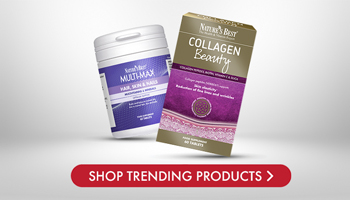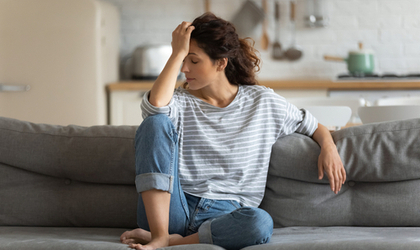
Hair has long been associated with youth and vitality. For men, hair represents virility; for women, hair embodies femininity. And so, losing it – for whatever reason – can be devastating and lead to low self-esteem, poor body image, and other emotional health issues.
There are many reasons why you may start to lose your hair: stress, hormonal imbalances, genetic factors, or medication. One factor that often gets overlooked is a nutritional deficiency – and, in particular, an iron deficiency.
If a blood test reveals that an iron deficiency is behind your hair loss, rest assured, you can reverse it with the necessary dietary changes.
Can iron deficiency cause hair loss?
Iron supports the production of haemoglobin in the blood. Crucially, haemoglobin carries oxygen and other nutrients to the hair’s cells, making it essential for growth. Without enough iron, haemoglobin can’t support hair health, which may eventually result in hair loss (1).
Evidence suggests that women between the ages of 18 and 50 with Chronic Telogen Effluvium (CTE) also have low iron levels in the body (2).
CTE is characterised by increased hair shedding that happens evenly across the scalp, as opposed to hair loss concentrated at the top of the head. This condition is often responsible for hair loss in menstruating women due to losing iron-containing blood each month.
If you have less hair to clip or tie back than before, or you notice an increase in the number of hairs lost when shampooing, brushing, or combing, then you may have CTE.
When an iron deficiency progresses into iron-deficiency anaemia – a condition in which you lack enough healthy red blood cells to transport oxygen around the body – it may also cause anaemia hair loss. (Link to article: Iron-deficiency anaemia: symptoms and causes)
What can cause an iron deficiency?
Eating a diet containing little or no red meat, pregnancy, and excessive exercise may give rise to a lower amount of available iron. (Link to article: Women and anaemia)
Low iron levels usually stem from blood loss for women with CTE during menstruation, which is just enough to cause a gradual decline of iron in the body.
How to increase your iron intake in diet?
Iron rich foods
Upping the quality and quantity of dietary iron is undoubtedly the best way to improve your overall iron status.
There are two types of iron: haem (from animal sources, especially red meat) and non-haem (from plant sources). It should be noted that haem iron is more bioavailable (absorbable) than non-haem iron.
Make an effort to eat a combination of haem and non-haem iron since haem iron can also support the absorption of non-haem iron when eaten together (3).
If you’re vegetarian or vegan, you’ll need to increase your intake of non-haem iron, particularly if you menstruate each month.
Vitamin C helps the body absorb iron, so you may wish to combine a vitamin C source with iron-rich foods (4). Citrus fruits and green leafy vegetables are packed with vitamin C.
Haem iron sources
-
Beef
-
Lamb
-
Pork
-
Poultry
-
Fish
Non-haem iron sources
-
Legumes
-
Pulses
-
Dark leafy vegetables
-
Tofu
-
Nuts
-
Seeds
Iron supplements
Besides dietary changes, taking a quality iron supplement will help cover any nutritional shortfalls you may encounter.
Try to find a formula that provides between 7mg-20mg of iron, depending on your gender and age.
-
Teenage girls (11-18 years) need 14.8mg daily
-
Teenage boys (11-18 years) need 11.3mg daily
-
Women (19-50 years) require 14.8mg daily
-
Men (19-50 years) require 8.7mg daily
-
Those above 50 years need 8.7mg daily
If you suspect that you have CTE, you need to supplement with 72mg of elemental iron daily for around 6 months. After this point, you’ll need at least 24mg iron daily or double if you menstruate heavily each month.
L-lysine, vitamin C, and vitamin B12 also support the absorption of iron. You can find relevant levels of these nutrients in our NutriHair® formula, specially designed for women with CTE.
Lifestyle changes to support hair health
Beyond increasing your dietary intake of iron, consider treating your hair with more care:
-
Always brush and style your hair gently
-
Avoid pulling your hair tightly back into a ponytail
-
Avoid harsh chemical treatments, like perms. Consider using organic hair dye.
-
Give yourself daily scalp massages
Next steps
Although hair loss can be deeply upsetting, try to find comfort in the fact that you can change the outlook of your situation. If an iron deficiency is causing hair loss, you can easily reverse it with the right dietary changes.
To check your iron levels, your GP will arrange for you to take a ferritin blood test. The amount of iron stored by the body is analysed by its blood ferritin levels. Ferritin is a protein that stores iron in the body, making it a useful marker of your overall iron status.
If your ferritin levels are below 70µg/L, it may signal that an iron deficiency is behind your hair loss. But with this knowledge, you can implement the steps outlined above and support new hair growth.
Head back to our dedicated blog to learn more about how iron supports your health and wellbeing.
References
- Trost LB, Bergfeld WF, Calogeras E. (2006) The diagnosis and treatment of iron deficiency and its potential relationship to hair loss. J Am Acad Dermatol. 54(5): 824-44.
- Rushton, D., 1993. Management of Hair Loss in Women. Dermatologic Clinics, 11(1), 47-53.
- Bda.uk.com. 2021. Iron. [ONLINE] Available at: https://www.bda.uk.com/resource/iron-rich-foods-iron-deficiency.html
- Hurrell R, Egli I. (2010) Iron bioavailability and dietary reference values. Am J Clin Nutr. 91(5): 1461S-1467S.
Related Posts
Disclaimer: The information presented by Nature's Best is for informational purposes only. It is based on scientific studies (human, animal, or in vitro), clinical experience, or traditional usage as cited in each article. The results reported may not necessarily occur in all individuals. Self-treatment is not recommended for life-threatening conditions that require medical treatment under a doctor's care. For many of the conditions discussed, treatment with prescription or over the counter medication is also available. Consult your doctor, practitioner, and/or pharmacist for any health problem and before using any supplements or before making any changes in prescribed medications.

Keri
Keri Filtness has worked in the Nutrition Industry for 19 years. She is regularly called upon for her professional comments on health and nutrition related news. Her opinions have been featured by BBC3, Prima, Vitality, The Mirror, Woman’s Own and Cycling Weekly, amongst others. She has also worked one to one with journalists, analysing their diets and health concerns and recommending changes and additions, where appropriate.



